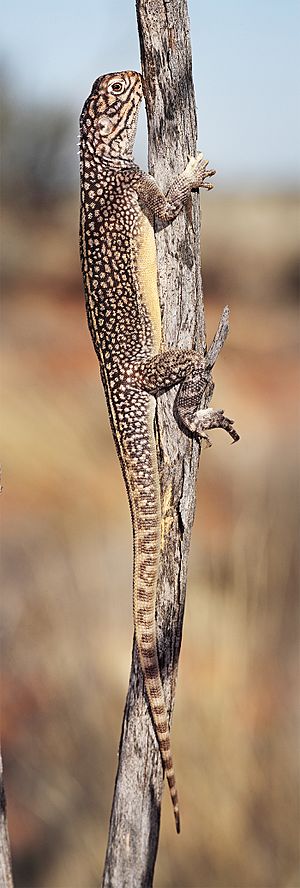Central netted dragon facts for kids
Quick facts for kids Central netted dragon |
|
|---|---|
 |
|
| Conservation status | |
| Scientific classification | |
| Genus: |
Ctenophorus
|
| Species: |
nuchalis
|
 |
|
| Distribution of the central netted dragon | |
The central netted dragon is a cool lizard found in the dry, sandy deserts of Australia. It's known for its amazing camouflage and quick movements. You might even see one in a zoo!
These dragons are widespread across Australia. They love open, sandy areas in the desert.
Contents
What Does a Central Netted Dragon Look Like?
These dragons are medium-sized lizards that live on the ground. They have a reddish-brown or orange-brown body. Their name comes from the dark, net-like pattern on their head and body. This pattern helps them hide from predators by blending into the desert.
They have short, strong legs with long toes and claws. This helps them run super fast and dig burrows quickly. Their head is short and blunt. They have exposed ears and small spines around their head. A low crest runs along their neck. Their body scales are small and smooth.
Adult males are about 25–28 cm long from nose to tail. About 10 cm of this is their body, and the rest is their tail. Males are a bit bigger than females. They also have a larger head compared to their body. These dragons usually live for 2 to 4 years in the wild.
Where Do Central Netted Dragons Live?
Central netted dragons live across the desert plains of Western Australia. You can also find them in the Northern Territory, Western Queensland, and New South Wales. They are common in open, sandy places with not much plant life. They seem to do well in areas where animals graze or where land has been cleared.
How Do They Live in the Desert?
Central netted dragons are active during the day. They spend their days basking in the sun on logs, stones, or termite mounds. Like most reptiles, they are ectotherms. This means they use their environment to control their body temperature.
Their day starts by warming up in the sun. This gives them energy. Without enough body heat, they can't digest their food. When the desert gets too hot, they go into their burrows to cool down. They might also climb plants to escape the extreme heat.
They often have several burrows, usually six to eight. These burrows are often at the base of spinifex grasses. They are shallow and have a dead end. Dragons use them to sleep at night and to escape from predators. They often block the entrance to their burrow. This keeps predators out and the heat away.
They like to perch on high spots. Termite mounds, dirt hills, logs, and fence posts are favorite spots. Termite mounds are also a good source of food for them.
How Do They Communicate?
Central netted dragons communicate by bobbing their heads and waving their legs. Male dragons can be very territorial. They use these display signs to scare off other males. This helps them protect their space.
How Do Central Netted Dragons Reproduce?
Central netted dragons lay eggs. Females usually lay two or three groups of eggs. Each group has two to six eggs. They lay eggs in spring and summer, depending on the location and weather. During the breeding season, males defend their territories. They often fight with other males for dominance.
Young dragons become adults after winter, when they are about 5-6 months old. The timing of their breeding depends on rainfall. After winter rains in the south, they breed predictably. In the north, they breed in late summer after big rains. Rainfall helps them survive, grow, and possibly lay more eggs.
What Do Central Netted Dragons Eat?
Central netted dragons have a varied diet. They mostly eat insects, but also flowers and other plants. They actively hunt for food. However, they often wait for an insect to pass by before quickly catching it.
In the wild, about 75% of their diet is insects. The other 25% is plants, like hogweed and small flowers. They are one of the most plant-eating desert lizards in Australia. They often share their habitat with many other lizard species. The insects they prefer are found in sandy areas. This is why they do well where there isn't much plant cover.
Who Are Their Predators?
Larger reptiles, like goannas and snakes, hunt central netted dragons. Birds of prey also hunt them. The red fox and cats are also predators. Burrows are their main way to escape. However, some predators, like snakes, can get into their burrows.
Are They in Danger?
Central netted dragons are not currently facing major threats. They can tolerate changes to their habitat caused by grazing animals.





